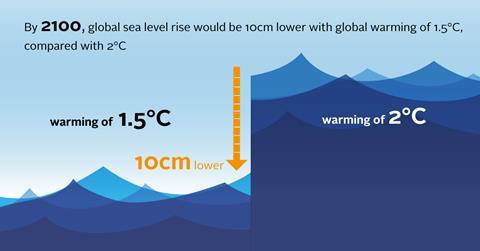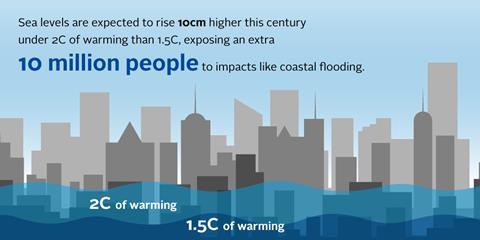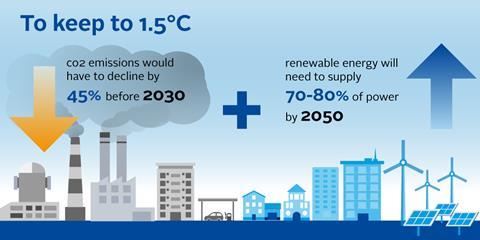Limiting warming to 1.5°C is possibly within the laws of chemistry and physics but doing so would require unprecedented changes
Jim Skea, Co-Chair of IPCCC Working Group III
Why does the IPCC report matter to PRI signatories?
Global Warming of 1. 5°C, an IPCC special report, was published by the Intergovernmental Panel on Climate Change (IPCC) on 8 October in the Republic of Korea. The report gives policy makers and practitioners, including investors, a very clear steer from scientists on the urgency of climate change and why 1.5°C matters.
- The scientists’ conclusions: the IPCC is the UN body for assessing the science related to climate change. Over 90 authors from 40 countries compiled evidence from 6,000 papers, with over 40,000 comments from experts and governments. The IPCC report authors mark certain statements as “high confidence” indicating strong consensus.
- How the report links to The Paris Agreement: the report was published in response to an invitation from UNFCCC (the United Nations Framework Convention on Climate Change) when it adopted the Paris Agreement in 2015. The Paris Agreement has specific text covering “holding the increase in the global average temperature to well below 2°C above pre-industrial levels and pursuing efforts to limit the temperature increase to 1.5°C above pre-industrial levels.”
How will the IPCC report impact the Paris Agreement?
Governments met in South Korea recently and agreed the 33-page summary of the IPCC report for policy makers with scientists. The report will be a key scientific input to COP24 in Poland, when governments will review the Paris Agreement, which 195 nations have adopted. The PRI’s conclusion is that governments need to significantly step up ambition to achieve the Paris Agreement goals.
How will the IPCC report impact the PRI’s activities?
Until recently, the PRI had focused on “well below 2 degrees” but the IPCC report highlights that the PRI and investors need to focus more urgently and explicitly on 1.5°C. The PRI’s Inevitable Policy Response: Act Now paper and research programme highlight the implications of a hard transition. The IPCC report confirms the PRI’s view that governments and investors will need to raise their ambition to avoid dangerous climate change.
Governments and investors will need to raise their ambition to avoid dangerous climate change
The PRI’s view is that 2025 Paris Agreement pledges appear strong candidates for forceful policy announcements by governments. Forceful policies would include carbon pricing, demand and supply-side policies. The drivers for forceful policy announcements include: the world is not on track for well below 2C and the need for certainty by business, falling costs of low carbon technology, evidence of climate change impacts, security issues and civil society unease at weather trends.
Forceful policy announcements by governments could have significant impacts on market stability, returns and asset allocation. The PRI sees three distinct periods: a pre-announcement phase, post-announcement phase and implementation phase. Institutional investors need to undertake forward-looking analysis of potential sources of risk and return to inform their strategic asset allocation decision-making process to be in a position where they can adequately respond to such forceful policies and a hard transition. The PRI’s 2019 work will include guidance on actions needed.
Meanwhile, the PRI encourages investors to participate in The Invesor Agenda. The Investor Agenda will be highlighted at COP24 in Poland in December 2018 and a focus point for accelerating global investor action towards both the 2019 UN Secretary General’s Climate Summit* and PRI in Person in Paris.
Speed read: main findings of the report
- Where we are: the world has already warmed since pre-industrial times due to human activity. We are already seeing the consequences of 1°C of global warming through more extreme weather, rising sea levels and diminishing Arctic sea ice. On current trends, the world is likely to pass 1.5°C between 2030-2052.
- A significant difference between 1.5°C and 2°C: The difference between 1.5°C and 2°C (the upper limit governments committed to in the Paris Agreement) is critical to millions of people. The risks at 1.5°C and 2°C are progressively higher. By 2100, global sea level rise would be 10cm lower with global warming of 1.5°C, compared with 2°C.
- Limiting global warming to 1.5°C requires unprecedented, rapid and far-reaching transitions in land, energy, industry, buildings, transport and cities. CO2 emissions would need to fall by 45% from 2010 levels by 2030, reaching net zero around 2050.

Deep dive: key topics in the report
- Understanding 1.5°C warming: the world is likely to pass 1.5°C between 2030-2052 unless urgent action is taken. The time lag between greenhouse gas emissions and their effect on climate means that the world is already committed to further warming and sea level rise, but past emissions are unlikely to tip temperatures over the 1.5°C threshold. To stabilise temperatures, emissions must reach net zero and stay there.
- Impacts and threats: global warming is already impacting people and ecosystems, but the risks at 1.5°C and 2°C are progressively higher. There will be worse heatwaves, drought and flooding at 2°C compared to 1.5°C.
- Sea levels are expected to rise 10cm higher this century under 2°C of warming than 1.5°C, exposing an extra 10 million people to impacts like coastal flooding. Sea levels will continue rising after temperatures have stabilised, and the collapse of ice sheets in Greenland and Antarctica could lead to rises of several metres. Slower warming buys time to adapt. 1.5-2.5 million square kilometres more permafrost will thaw this century under 2°C warming compared to 1.5°C, with thawing permafrost releasing methane, a greenhouse gas.

- The report predicts the proportion of species that will lose half their geographic range. Out of 105,000 species studied, the rate doubles between 1.5°C and 2°C warming to 16% for plants. 2°C virtually wipes out coral reefs, compared to a 70-90% decline at 1.5°C.
- The extra half a degree of warming has health implications, expanding the range of mosquitoes carrying diseases like malaria. The quantity and quality of staple crops suffers under 2°C warming compared to 1.5°C, impacting on food availability.
- Pathways to 1.5°C: To keep to 1.5°C, CO2 emissions would have to decline by 45% between 2010 and 2030, hitting net zero in 2050. This is significantly faster than needed for 2°C – a reduction of 20% by 2030 and net zero by 2075. Methane and black carbon will need to be cut by at least 35% by 2050, compared to 2010. Geoengineering is viewed as too uncertain to be relied on for staying within 1.5°C. The biggest polluting industries will need to make radical changes.
- In energy, renewables will need to supply 70%-85% of power by 2050.
- Energy-intensive industries will have to slash their CO2 by 75% to 90% by 2050 compared to 2010 to stick to 1.5°C. This compares to slashing their CO2 by 50% to 80% for a 2°C limit. This is achievable with new and existing technologies that are technically proven, but they need to be deployed on a large scale.
- Buildings and transport will need to shift heavily towards green electricity. Use of land will also be important.

- Ramping up action: The existing Paris Agreement national pledges are inadequate and in line with a 3°C temperature rise, leading to 52-58 gigatons of CO2 emissions a year in 2030. All pathways to 1.5°C require greenhouse gas emissions to fall below 35Gt/yr by then.
- The lower the emissions in 2030, the easier it will be to limit global warming to 1.5°C. Delay in cutting greenhouse gasses risks increasing the costs of reductions, locking countries into carbon-emitting infrastructure or stranding high-emission assets.
- The SDGs: Emissions reductions in line with 1.5°C can support the sustainable development goals for 2030, particularly goals around health, clean energy, cities and communities. Not managed, emissions reductions will impact on achievement of goals around poverty, hunger, water and energy access.
- Directing finance towards infrastructure that lowers emissions and adapts to climate change can help meet the 1.5°C goal, including from institutional investors and public funds. Governments can help with policies that lower the risk of investment in low-emissions and adaptation projects.
How can investors contribute to pathways to 1.5°C?
- Invest: The PRI encourages signatories to integrate climate into investment analysis and decisions, to scale-up low carbon investment and phase-out of thermal coal. The PRI’s guidance, How to invest in the low carbon economy, provides practical case studies and options for this. The PACTA tool enables climate scenario analysis, while our TCFD asset owner guide offers practical case studies for asset owners.
- The PRI’s new work programme, The Inevitable Policy Response: Act Now, will set out further actions investors need to take and guidance for these.
- Corporate engagement: the PRI encourages signatories to participate in Climate Action100+ to reduce emissions in systemically important emitters. The PRI’s collaborative investor engagements include deforestation, water, methane and corporate lobbying, as well as our 2 Degrees of Separation research with the Carbon Tracker Initiative focusing on the oil and gas industry.
- Policy advocacy: The 2018 Global Investor Statement provides an opportunity for investors to make their voice clear to governments in the Paris Agreement to enhance ambition. The PRI encourages signatories to engage in climate policy including the EU Sustainable Finance Action Plan and China’s green finance plans.
- Disclose: the PRI’s Reporting Framework climate indicators provide a way for signatories to disclose based on TCFD, while our climate snapshotis an interactive online tool for signatories to see how peers are acting on climate change.
The Investor Agenda: Already, over 400 investors (US$32 trillion) having participated in The Investor Agenda featured at the Global Climate Action Summit, and over 300 investors have signed a 2018 Global Investor Statement on Climate Change, urging all parties to the Paris Agreement to step up in ambition. The Investor Agenda will be highlighted at COP24 in Poland and at the UN 2019 Climate Summit.
The UN 2019 Climate Summit falls one year before countries have to enhance their national climate pledges under the Paris Agreement. The UN 2019 Climate Summit and PRI in Person in Paris will build on the 2018 Global Climate Action Summit and COP24. It will seek to challenge states, regions, cities, companies, investors and citizens to step up action in six areas: energy transition, climate finance and carbon pricing, industry transition, nature-based solutions, cities and local action, and resilience. It will convene on the theme “A Race We Can Win. A Race We Must Win.”
The PRI encourages investors to participate in the investment section of The Investor Agenda, to demonstrate they are acting to scale-up transformative investments and inspire governments to step up in ambition.







